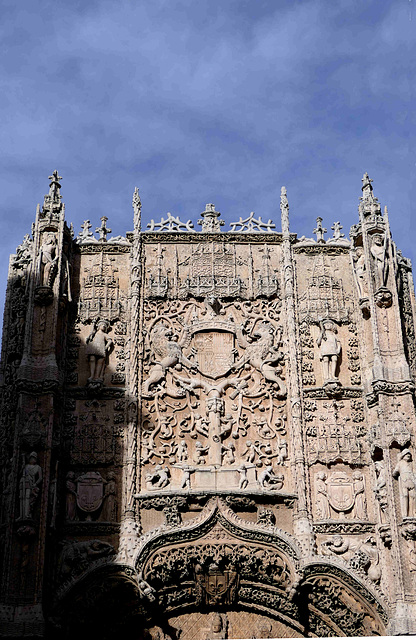Valladolid - Colegio de San Gregorio
Valladolid - Colegio de San Gregorio
Valladolid - Colegio de San Gregorio
Valladolid - Iglesia de San Pablo
Valladolid - Iglesia de San Pablo
Valladolid - Iglesia de San Pablo
Valladolid - Art Nouveau
Valladolid - Christmas Market
Valladolid - Christmas Market
Valladolid
Benavente - Mercado de Abastos
Benavente - Santa María del Azogue
Benavente - San Juan del Mercado
Benavente - Santa María del Azogue
Benavente - Santa María del Azogue
Benavente - Santa María del Azogue
Benavente - San Juan del Mercado
El Campillo - San Pedro de la Nave
El Campillo - San Pedro de la Nave
El Campillo - San Pedro de la Nave
El Campillo - San Pedro de la Nave
Zamora - Douro
Zamora - Aceñas de Olivares
Valladolid - Colegio de San Gregorio
Valladolid - Santa María La Antigua
Valladolid - Santa María La Antigua
Valladolid - Universidad de Valladolid
Valladolid - Palacio de Pimentel
Valladolid - Miguel de Cervantes
Valladolid - Plaza Mayor
Peñafiel - Plaza del Coso
Peñafiel - Convento de San Pablo
Aranda de Duero - Santa María la Real
Aranda de Duero - Santa María la Real
Aranda de Duero - Puente Románico de las Tenerías
Aranda de Duero - San Juan Bautista
Aranda de Duero - San Juan Bautista
Venta de Baños - San Juan de Baños
Venta de Baños - San Juan de Baños
Venta de Baños - San Juan de Baños
Venta de Baños - San Juan de Baños
Palencia - Lavandería Speed Queen
Palencia - Mercado de Abastos
Palencia - Cines Ortega
Palencia - Museo Arqueológico Provincial
Location
Keywords
Authorizations, license
-
Visible by: Everyone -
All rights reserved
-
25 visits
Valladolid - Colegio de San Gregorio


In the 8th century, Arab-Moorish armies advanced into the north of the Iberian Peninsula, but as early as the 10th century the area was temporarily reconquered by the Christians (Reconquista). In the late 11th century, Count Pedro Ansúrez made the largely depopulated city his residence, expanded it, and promoted its repopulation (repoblación), which is why he is often considered the actual founder of the city. The University of Valladolid was founded in 1241 by Alfonso VIII of Castille. It is one of the oldest universities in the world.
In the 15th century, it became the capital of the Kingdom of Castile until Philip II moved the center of power to the newly built monastery residence Real Sitio de San Lorenzo de El Escorial near Madrid in 1561. In 1561 most of the city burned down but was rebuilt under Philip II.
The Colegio de San Gregorio was formerly a university and now houses the “Museo Nacional de Escultura”. This building is one of the best examples of the architectural Gothic style known as Isabelline.
The University of Valladolid was founded in the 13th century by Alfonso X ("the Wise"). This also meant that over time so-called "colegios" /colleges emerged alongside or in connection with the university.
So this colegio was founded as a teaching institution. As a theological college for Dominican monks. With papal approval, work began in 1488. The construction of the college was probably completed in 1496. The college accommodated around 20 students at a time.
The main facade is spectacular. By its stylistic features, it sets regarding the workshop of Gil de Siloé, a Flemish-origin artist, who was at that time in Burgos dealing with the royal sepulchers of the Miraflores Charterhouse.
The upper part of the facade
In the 15th century, it became the capital of the Kingdom of Castile until Philip II moved the center of power to the newly built monastery residence Real Sitio de San Lorenzo de El Escorial near Madrid in 1561. In 1561 most of the city burned down but was rebuilt under Philip II.
The Colegio de San Gregorio was formerly a university and now houses the “Museo Nacional de Escultura”. This building is one of the best examples of the architectural Gothic style known as Isabelline.
The University of Valladolid was founded in the 13th century by Alfonso X ("the Wise"). This also meant that over time so-called "colegios" /colleges emerged alongside or in connection with the university.
So this colegio was founded as a teaching institution. As a theological college for Dominican monks. With papal approval, work began in 1488. The construction of the college was probably completed in 1496. The college accommodated around 20 students at a time.
The main facade is spectacular. By its stylistic features, it sets regarding the workshop of Gil de Siloé, a Flemish-origin artist, who was at that time in Burgos dealing with the royal sepulchers of the Miraflores Charterhouse.
The upper part of the facade
Paolo Tanino, kiiti, Alexander Prolygin have particularly liked this photo
- Keyboard shortcuts:
Jump to top
RSS feed- Latest comments - Subscribe to the comment feeds of this photo
- ipernity © 2007-2024
- Help & Contact
|
Club news
|
About ipernity
|
History |
ipernity Club & Prices |
Guide of good conduct
Donate | Group guidelines | Privacy policy | Terms of use | Statutes | In memoria -
Facebook
Twitter

Sign-in to write a comment.